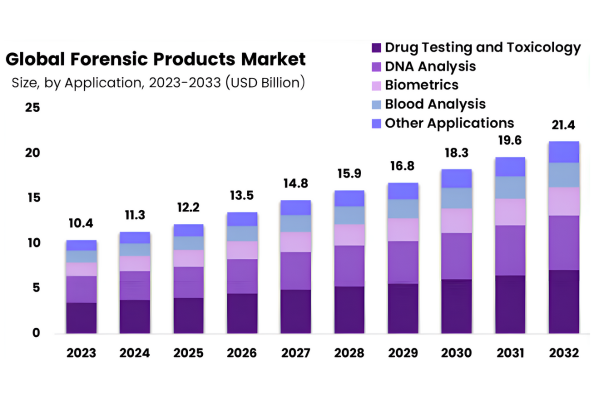"Forensics: An Evidence to Justice"
Welcome to the Webinar on Forensic Science which is going to be held on October 30, 2025 through Online. A platform dedicated to exploring the intersection of science, law, and justice. We are honored to have with us a distinguished gathering of forensic experts, researchers, law enforcement professionals, and students who share a deep commitment to uncovering the truth through scientific inquiry. This event offers a unique opportunity to delve into the latest advancements, methodologies, and technologies shaping the area—from crime scene investigation to digital forensics, toxicology, and beyond. We look forward to thought-provoking discussions, knowledge exchange, and collaborative learning that will inspire innovation and strengthen the vital role of forensic science in modern justice systems.
Forensic Science is a dynamic and interdisciplinary branch of science that plays a pivotal role in the criminal justice system by applying scientific methods to investigate crimes and analyze evidence. It encompasses a wide range of specialties, including forensic pathology, DNA analysis, toxicology, ballistics, digital forensics, handwriting analysis, and forensic anthropology, each contributing vital information to solve complex cases. Forensic scientists work closely with law enforcement agencies, legal professionals, and medical examiners to interpret physical evidence from crime scenes, such as fingerprints, bodily fluids, weapons, and digital data. Through meticulous examination and the use of advanced technologies, they help identify victims and suspects, determine causes of death, and reconstruct the sequence of events. Beyond criminal investigations, forensic science also contributes to civil cases, disaster victim identification, and human rights investigations. Its accuracy, objectivity, and scientific rigor make it an indispensable tool in the pursuit of truth and justice in modern society.

Forensic science is the application of scientific principles and techniques to investigate crimes and analyze evidence in the pursuit of justice. It combines various disciplines such as biology, chemistry, physics, and digital technology to examine physical evidence like DNA, fingerprints, blood samples, weapons, and digital data. Forensic experts play a crucial role in criminal investigations by helping law enforcement agencies identify suspects, reconstruct crime scenes, and present scientific findings in court. Fields within forensic science include toxicology, pathology, ballistics, digital forensics, and trace evidence analysis. With advancements in technology, forensic science continues to evolve, improving the accuracy, speed, and reliability of crime-solving efforts. It not only aids in criminal justice but also contributes to areas like civil law, disaster victim identification, and historical investigations.
Fingerprint analysis is a fundamental technique in forensic science used to identify individuals based on the unique patterns found in their fingerprints. No two people, not even identical twins, have the same fingerprints, making them a highly reliable form of identification. The process involves comparing ridge patterns, minutiae points, and loop, whorl, or arch structures found in fingerprint impressions. Investigators collect latent prints from crime scenes using powders, chemicals, or alternate light sources, and then match them to known prints in databases such as AFIS (Automated Fingerprint Identification System). Fingerprint analysis is crucial in criminal investigations, helping to place suspects at crime scenes or verify identities. Advances in digital imaging and biometric technology have made fingerprint analysis faster and more accurate, reinforcing its role as a cornerstone of modern forensic science.
Cyber forensics, also known as digital forensics, is a specialized branch of forensic science focused on the investigation and recovery of data from digital devices such as computers, smartphones, servers, and networks. It plays a critical role in solving cybercrimes like hacking, identity theft, data breaches, online fraud, and cyberterrorism. Cyber forensic experts use advanced tools and techniques to collect, preserve, analyze, and present digital evidence in a legally admissible manner. This includes recovering deleted files, tracing IP addresses, examining email and chat logs, and analyzing malware. Cyber forensics is essential not only in criminal investigations but also in corporate and civil cases involving data leaks, intellectual property theft, or employee misconduct. With the rise in cybercrime globally, this field continues to expand, combining elements of computer science, cybersecurity, and law enforcement to protect digital integrity and ensure justice.
Artificial Intelligence (AI) in forensics is revolutionizing how criminal investigations are conducted by enhancing the speed, accuracy, and efficiency of evidence analysis. AI technologies are being used in various forensic applications such as facial recognition, voice and speech analysis, pattern recognition, and predictive crime mapping. Machine learning algorithms can analyze vast amounts of forensic data—like fingerprints, DNA sequences, digital evidence, and surveillance footage—much faster than human experts. In digital forensics, AI assists in detecting anomalies, retrieving deleted data, and identifying cyber threats. AI-powered tools can also support criminal profiling and help law enforcement agencies make more informed decisions. While AI offers tremendous benefits, ethical considerations such as bias, privacy, and accountability remain key areas of discussion. As AI continues to evolve, its integration in forensic science holds great promise for transforming the future of justice and public safety.
Forensic psychology is a dynamic field that bridges the gap between psychology and the legal system. It involves the application of psychological principles and methods to understand criminal behavior, assess mental competency, and assist in legal proceedings. Forensic psychologists often work with law enforcement, courts, and correctional facilities to perform tasks such as criminal profiling, risk assessment, evaluating the mental state of defendants, and providing expert testimony in court. They may also be involved in cases related to child custody, abuse, and rehabilitation of offenders. This discipline plays a critical role in understanding the psychological factors behind crime and helping to ensure that justice is served fairly and ethically. With the increasing recognition of mental health issues in the legal system, forensic psychology continues to grow in importance and influence.
Forensic DNA analysis and genomics are powerful tools in modern forensic science used to identify individuals and solve crimes with high precision. DNA analysis involves examining specific regions of a person’s genetic code to match biological evidence—like blood, saliva, or hair—to potential suspects or victims. This technique has revolutionized criminal investigations, enabling the resolution of cold cases, exoneration of the wrongly convicted, and identification of missing persons. With the advancement of genomic technologies, forensic scientists can now analyze entire genomes, discover genetic markers linked to ancestry, and even predict physical traits such as eye color or hair texture through forensic phenotyping. Techniques like PCR (polymerase chain reaction), STR (short tandem repeat) profiling, and next-generation sequencing (NGS) have greatly enhanced the sensitivity and speed of DNA testing. Forensic genomics is not only transforming crime-solving but also raising important ethical questions around privacy and the use of genetic data in investigations.
Digital and cyber forensics is a specialized area within forensic science that focuses on the identification, preservation, analysis, and presentation of digital evidence related to cybercrimes and electronic data breaches. It encompasses the examination of computers, mobile devices, cloud systems, and networks to uncover illegal activities such as hacking, fraud, identity theft, data leaks, and cyberterrorism. Digital forensics experts use advanced software and methodologies to recover deleted files, trace online activities, decrypt encrypted data, and monitor suspicious digital behavior. Key subfields include computer forensics, network forensics, mobile device forensics, and malware forensics. As cyber threats continue to evolve, this field plays an essential role in both criminal investigations and corporate cybersecurity, helping organizations and law enforcement agencies detect, respond to, and prevent cyber incidents. Digital and cyber forensics not only strengthen digital security frameworks but also ensure that digital evidence holds up in court.
Forensic toxicology is the branch of forensic science that deals with the detection and analysis of drugs, alcohol, poisons, and other toxic substances in biological samples such as blood, urine, hair, or tissues. This field plays a crucial role in investigating cases of suspicious deaths, drug overdoses, poisoning, driving under the influence (DUI), and workplace drug testing. Forensic toxicologists use sophisticated analytical techniques like gas chromatography-mass spectrometry (GC-MS) and high-performance liquid chromatography (HPLC) to identify and quantify substances in the body. Their work helps determine whether a substance contributed to or caused a person's death or impaired behavior. In addition to criminal cases, forensic toxicology is also applied in civil litigation, sports doping investigations, and public health research. As new synthetic drugs and environmental toxins emerge, this field continues to evolve, playing a vital role in ensuring justice and public safety.
Crime scene investigation (CSI) techniques are a crucial part of forensic science, focusing on the systematic collection, documentation, preservation, and analysis of physical evidence from a crime scene. Investigators use a variety of specialized methods to ensure that every piece of evidence is accurately recorded and uncontaminated. Key techniques include scene photography, sketching, evidence tagging, and chain of custody documentation. Tools like fingerprint dusting kits, UV light sources, blood spatter analysis, and chemical tests are used to uncover latent evidence such as fingerprints, trace fibers, gunshot residues, or bodily fluids. Advanced methods like 3D laser scanning, drones for aerial surveys, and digital reconstruction are now being used for greater precision and accuracy. Proper crime scene investigation ensures that crucial forensic evidence is available for laboratory analysis and courtroom presentation, ultimately contributing to the successful resolution of criminal cases.
Forensic anthropology and odontology are specialized areas within forensic science that focus on identifying human remains and uncovering details about a person's life and death. Forensic anthropology involves the analysis of skeletal remains to determine characteristics such as age, sex, ancestry, stature, and signs of trauma or disease. This information is crucial in mass disasters, archaeological investigations, and cases involving unidentified bodies or suspected foul play. Forensic odontology, on the other hand, applies dental science to identify individuals through dental records, analyze bite marks, and estimate age based on tooth development. Teeth are often well-preserved, even when other body parts are not, making dental evidence a valuable tool in forensic identification. Together, these disciplines contribute significantly to criminal investigations, disaster victim identification, and historical or war crime research, providing answers when traditional methods fall short.
Forensic pathology and autopsy science are essential branches of forensic science focused on determining the cause, manner, and time of death through the examination of deceased individuals. Forensic pathologists, also known as medical examiners, perform autopsies to investigate unnatural, suspicious, or unexplained deaths. During an autopsy, they assess external injuries, examine internal organs, and collect tissue and fluid samples for further analysis. These examinations can reveal evidence of trauma, poisoning, disease, or foul play. Forensic pathology also involves collaborating with toxicologists, crime scene investigators, and law enforcement to piece together the circumstances surrounding a death. Autopsy findings play a critical role in criminal investigations, court testimonies, and public health surveillance. With advances in imaging technologies like post-mortem CT scans and virtual autopsies, the field continues to evolve, enhancing both accuracy and non-invasive examination techniques.
Forensic biology is a vital discipline within forensic science that focuses on the analysis of biological evidence to support criminal investigations. It involves the examination of materials such as blood, hair, saliva, semen, skin cells, and other bodily fluids to help identify individuals involved in a crime. One of the most prominent techniques used in forensic biology is DNA profiling, which allows for precise identification through genetic material. This field also includes serology, the study of bodily fluids, and entomology, the use of insects to estimate time of death. Forensic biologists often work closely with law enforcement and forensic pathologists to reconstruct crime scenes and provide crucial evidence in both criminal and civil cases. Advances in molecular biology, such as rapid DNA analysis and microbial forensics, continue to expand the capabilities of forensic biology, making it an increasingly powerful tool in the pursuit of justice.
Forensic chemistry is a critical branch of forensic science that involves the identification and analysis of chemical substances found at crime scenes. Forensic chemists examine physical evidence such as drugs, explosives, toxins, gunshot residues, fire accelerants, and unknown powders or liquids to determine their composition and origin. Using sophisticated analytical techniques like gas chromatography (GC), mass spectrometry (MS), infrared spectroscopy (IR), and thin-layer chromatography (TLC), they can detect trace amounts of substances and provide crucial information in criminal investigations. Forensic chemistry plays a key role in cases involving drug trafficking, arson, poisoning, and environmental contamination. It also helps establish links between suspects and crime scenes by analyzing evidence left behind. As technology advances, forensic chemists continue to develop faster, more sensitive, and more accurate methods, strengthening the scientific foundation of law enforcement and judicial systems.
Digital forensics, also known as computer forensics, is a specialized field focused on investigating and analyzing digital devices to uncover evidence related to cybercrime. With the rapid growth of technology and online activity, cybercrimes—such as hacking, identity theft, online fraud, cyberbullying, ransomware attacks, and intellectual property theft—have become increasingly common. Digital forensic experts use advanced tools and techniques to recover deleted files, trace digital footprints, examine metadata, and identify unauthorized access across computers, mobile devices, and networks. They follow a strict process to preserve the integrity of digital evidence for use in legal proceedings. Digital forensics not only supports criminal investigations but also helps in corporate and civil disputes, data breach investigations, and cybersecurity incident response. As cyber threats continue to evolve, this field remains essential in protecting digital assets and ensuring accountability in the digital world.
Wildlife forensics is a specialized branch of forensic science dedicated to investigating crimes against wild animals and enforcing wildlife protection laws. This field plays a crucial role in combating illegal poaching, wildlife trafficking, habitat destruction, and violations of conservation regulations. Wildlife forensic scientists analyze evidence such as animal DNA, hair, feathers, bones, and tissue samples to identify species, determine cause of death, and trace the geographic origin of wildlife products. Techniques like DNA barcoding, microscopy, and toxicological analysis help in tracking down perpetrators and supporting legal actions. Wildlife forensics also assists in enforcing international treaties like CITES (Convention on International Trade in Endangered Species of Wild Fauna and Flora). As biodiversity faces increasing threats, wildlife forensics contributes not only to criminal justice but also to conservation efforts by protecting endangered species and maintaining ecological balance.
Our webinars are thoughtfully designed to deliver value to a wide range of individuals. Whether you're looking to grow your skills, explore new opportunities or gain insights from experts, here's who will benefit most from attending:
If you're aiming to advance in your career or stay updated with the latest trends in your field, this webinar is perfect for you. Gain actionable insights and learn from industry experts.
Professors, scholars, and students presenting findings or exploring the latest research in their field and individuals looking for collaboration opportunities.
Discover strategies, tools, and techniques to scale your business, enhance productivity, and achieve your goals. This is your chance to learn from real-world success stories.
Are you curious about new concepts or looking to bridge the gap between academia and industry? Our webinars provide practical knowledge that goes beyond textbooks.
Stay ahead of the curve! If you're passionate about the topic and want to understand the latest innovations, trends, or developments, you'll find immense value here.
In a world where knowledge is power, webinars have emerged as one of the most accessible and impactful ways to learn, grow and connect. Don't miss the chance to learn, grow and connect in ways that truly matter.
Webinars are often hosted by industry experts, thought leaders, and innovators. Attending gives you direct access to their insights, strategies, and expertise that you can immediately apply in your personal or professional life.
The digital world evolves rapidly. Webinars provide up-to-date information on the latest trends, tools, and techniques, ensuring you stay ahead of the curve in your industry or area of interest.
Webinars aren't just passive presentations they're dynamic and interactive. Participate in live Q&A sessions, answer polls, and share your thoughts with like-minded participants.
Webinars connect you with professionals, experts, and enthusiasts from around the globe. It's a unique opportunity to grow your network and collaborate with others who share your interests.
Many webinars are free or available at a fraction of the cost of in-person events. This makes them an affordable way to learn from experts without incurring travel or accommodation expenses.
Webinars often include access to resources such as presentation slides, e-books and recordings. These materials ensure you can revisit the content and reinforce your learning anytime.
A great webinar can spark new ideas and reinvigorate your passion for a topic. The insights you gain may open new opportunities or provide the push you need to achieve your goals.
Webinars are designed with specific audiences in mind. Whether you're seeking professional development, personal growth, or technical know-how, you're likely to find a webinar that suits your interests perfectly.
Stay ahead of the curve! If you're passionate about the topic and want to understand the latest innovations, trends, or developments, you'll find immense value here.
Best platform for Global business and Networking opportunities B2B Meetings Poster Sessions on every career stage Networking Opportunities
Registering for a webinar is essential to gain access to the unique opportunities and secure a chance to grow, connect and gain insights that can drive your personal and professional success. Webinars are more than just online meetings, they're gateways to knowledge, innovation, and growth.

The global forensic science market is experiencing steady growth, driven by the rising need for advanced investigative tools in criminal justice systems and increased crime rates worldwide. Valued at approximately USD 7.8 billion in 2023, the market is projected to reach around USD 13.5 billion by 2030, growing at a compound annual growth rate (CAGR) of 8–9%. This expansion is fueled by the growing adoption of technologies such as DNA profiling, digital forensics, and biometric analysis, along with increased investment by governments in forensic infrastructure and laboratories. The surge in cybercrimes and digital offenses has especially boosted demand for cyber and digital forensics, while traditional areas like toxicology, fingerprint analysis, and ballistics continue to hold strong relevance. North America currently leads the market due to its advanced forensic facilities and legal frameworks, but regions like Asia-Pacific are showing rapid growth due to rising awareness, modernization of law enforcement, and increased spending on public safety. Additionally, private forensic labs and academic research collaborations are contributing to innovation, making forensic science a key pillar in modern crime-solving and legal adjudication.





